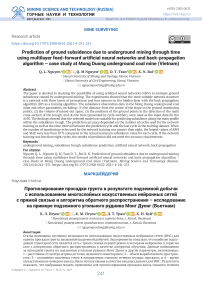Prediction of ground subsidence due to underground mining through time using multilayer feed-forward artificial neural networks and back-propagation algorithm - case study at Mong Duong underground coal mine (Vietnam)
Автор: Nguyen Quoc Long, Nguyen Quang Minh, Tran Dinh Trong, Bui Xuan Nam
Журнал: Горные науки и технологии @gornye-nauki-tekhnologii
Рубрика: Маркшейдерия
Статья в выпуске: 4 т.6, 2021 года.
Бесплатный доступ
The paper is devoted to studying the possibility of using artificial neural networks (ANN) to estimate ground subsidence caused by underground mining. The experiments showed that the most suitable network structure is a network with three layers of perceptrons and four neurons in the hidden layer with the back propagation algorithm (BP) as a training algorithm. The subsidence observation data in the Mong Duong underground coal mine and other parameters, including: (1) the distance from the centre of the stope to the ground monitoring points; (2) the volume of mined-out space; (3) the positions of the ground points in the direction of the main cross-section of the trough; and (4) the time (presented by cycle number), were used as the input data for the ANN. The findings showed that the selected model was suitable for predicting subsidence along the main profile within the subsidence trough. The prediction accuracy depended on the number of cycles used for the network training as well as the time interval between the predicted cycle and the last cycle in the training dataset. When the number of monitoring cycles used for the network training was greater than eight, the largest values of RMS and MAE were less than 10 % compared to the actual maximum subsidence value for each cycle. If the network training was less than eight cycles, the results of prediction did not meet the accuracy requirements.
Underground mining, subsidence trough, subsidence prediction, artificial neural network, back propagation
Короткий адрес: https://sciup.org/140290237
IDR: 140290237 | DOI: 10.17073/2500-0632-2021-4-241-251
Текст научной статьи Prediction of ground subsidence due to underground mining through time using multilayer feed-forward artificial neural networks and back-propagation algorithm - case study at Mong Duong underground coal mine (Vietnam)
Underground mining produces large goaf that unbalances natural stress in the ground. Then gravity forces the soil and rock above to tend towards filling the goaf below to achieve a new equilibrium [1]. This filling process causes ground subsidence with formation of a subsidence trough, which is dangerous to natural and man-made structures located on the surface. Therefore, special interest is paid to monitoring and prediction of subsidence within mining areas in the world [2–4] and in Vietnam [5].
The studies of ground surface subsidence prediction through time mostly use mathematical models, in which the exponential function proposed by Knothe is mostly applicable due to its advantage of allowing predicting the subsidence of monitoring points on the surface through time [11–13]. However, the ground surface subsidence due to underground mining is a complicated process, and it cannot be fully described by the Knothe function, so the accuracy of subsidence prediction is not rather high in some cases [12, 14]. To overcome this problem, several extension forms of Knothe function were proposed [13, 15], e.g. adding a parameter to this function to describe the most realistic subsidence process and thereby optimising subsidence prediction [12, 15]. Gonzalez-Nicieza et al. [16] used the prediction function of Knothe-Sroka-Schober to develop a new prediction function and applied it to the Central Asturian coal basin. Their subsidence prediction results proved to be close to the actual subsidence observations. Liu et al. [17] developed the function for subsidence prediction through time on the basis of Harris function and achieved more accurate results compared to applying the original Harris function.
The above studies on ground surface subsidence prediction through time focussed mainly on the prediction for each monitoring point. Its advantage is suitability for the prediction of subsidence under structures on the surface, but the disadvantage is the subsidence prediction at the monitoring point only, while the subsidence in any other point is interpolated from the subsidence in the monitoring points. To overcome these limitations applying ANN was suggested to predict subsidence as well as determine the subsidence value in any points in the subsidence trough at any time. With the advantage of being a non-model based method, ANN is easy to test and modify using different groups of input parameters. Thus, ANN seems to be the most suitable method for predicting and interpolating surface subsidence through time in mining areas, especially at underground coal mines such as in Quang Ninh, Vietnam.
Depending on the availability of training data, ANN can be used to predict subsidence in many cases such as predicting subsidence in the planning phase or predicting subsidence in the mining phase. For the case of predicting in the planning phase, a lot of training data on many different mining condition parameters is needed. With such training data ANN is capable to be predictable https://mst.misis.ru/
2021;6(4):241–251
during mining phase too. However, it is quite difficult to collect such training data nowadays.
In this study, we tested the prediction of subsidence at underground mines through time during mining phase using training data, consisted of data of historical subsidence monitoring at Mong Duong underground coal mine (Quang Ninh, Vietnam). The testing results allowed evaluating the effect of the number of training cycles as well as the ANN ability to predict surface subsidence at underground coal mines in Quang Ninh area.
2. Function of subsidence prediction for Multi-Layer Perceptron ANN
The most widely used ANN model is the Multi-Layer Perceptron (MLP) (Fig. 1). A general MLP is a network with nodes, or neurons, connected to each other and placed in n layers, including the input layer (which was not taken into account in some studies), the output layer ( nth layer) and the hidden layer ( n - 1). The input neurons are not neurons in a very real sense, because they do not perform any computations with the input data, but they simply accept the input data and transmit them to the next layer [18]. The neurons of the following layer are connected with and receive data from the neurons of the previous layer (the data are not transmitted in the opposite direction, so this network is called “feed-forward neural network”).
Input layer
Hidden layers
Output layer xm
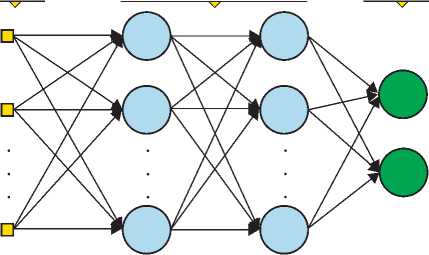
In a multilayer feed-forward neural network, the output value of one layer becomes the input value for the next layer. The output value of each neuron is defined as follows:
У ( l ) = f
N l - 1
^j , I - 1) y ( l - 1) + bi i =1
In which:
yi(l) is the output value of the ith neuron in layer l (l = 1,…, L and i = 1, …, Nl), to(l, l-1) is the weight that links the jth neuron of class l - 1 to the ith neuron of class l.
The function f is chosen based on specific requirements. In subsidence prediction, a sigmoid function is often used (Eq. 2) because of smoothness of this function. Furthermore, this function is especially convenient for using in ANNs training by back- propagation algorithm, because it is easy to derive, and the amount of computations in the training process can be significantly reduced.
f ( x ) = 1Т. (2)
1 + e x
3. Selection of input data for ANN in ground surface subsidence prediction through time
When all the neurons in a layer have completed their computations, the next layer can start the computations, because the outputs of the previous layer are combined with the associated weights and become the inputs for the next layer. When all the neurons have completed the computations then the output neurons produce the result. In order to get the desired outputs, in the training data and training process, the associated weights of the neural network should be adjusted. The algorithms that determine the associated weights of the cycle data are called network training algorithms. Among these algorithms, the most popular one for MLP networks is back-propagation algorithm [19].
Same to feed-forward neural networks used for other purposes, the feed-forward neural network used in surface subsidence prediction in the mining area consists of 3 layers, including: input layer, hidden layer, and output layer. The input layer consists of neurons, each of which receives an input value that is a factor influencing the surface subsidence. The hidden layer consists of neurons that determine general relationship between the parameters influencing the surface subsidence. The output layer has only one neuron and the output value of this neuron is the predicted subsidence value. These three layers are connected: all the neurons of the input layer are connected to each neuron of the hidden layer, and these connections are represented by associated weights in the network training process. Similarly, each neuron of the hidden layer is connected to the neuron of the output layer.
The parameters influencing the surface deformation process are topography, soil and rock mechanical properties, thickness and dip angle of the coal seam, average mining depth, etc. Among these parameters, soil and rock mechanical properties commonly do not change through time in the same mining area, so they are not selected as input factors [20].
The parameters of topography, coal seam dipe angle, average mining depth are characterized by the distance from the center of a stope to the monitoring points on the surface at the time of subsidence monitoring. The size of coal mining stope (underground working) changes through time, so the distance from its center to the monitoring points on the surface also changes. The symbol for this distance between monitoring point ith and the center at subsidence monitoring time T is L t i .
The factors of average thickness of the coal seam, shape and size of the stope and mining progress are characterized by the volume of the mining stope (or the volume of coal extracted) through time are denoted as Vt .
2021;6(4):241–251
The coordinates of the monitoring points i on the main profiles of the subsidence trough are ( Xi , Yi ) in the coordinate system whose origin is the center of the subsidence trough (this center is determined based on the maximum subsidence angle ( θ ) or subsidence monitoring data). In the direction of the coal seam dip, the coordinates of the monitoring point are Yi = 0 , Xi ≠ 0 ( Xi is negative at points located on the opposite slope of the subsidence trough and vice versa). In the strike direction, the coordinates of the monitoring point are Xi = 0 , Yi ≠ 0 ( Yi is negative at points located in the direction of the mining starting and vice versa). The monitoring time is an important input parameter; as time goes on, other parameters such as the distance from the center of a coal mining stope to monitoring points on the surface and the volume of the stope (coal extracted) change. The symbol Ti is time of subsidence monitoring in ith cycle, Ti + n is the time of subsidence prediction ( n is the time interval between subsidence monitoring cycles).
Thus, 4 input parameters selected for ANN in predicting underground mining-caused ground subsidence through time include: monitoring time ( Ti ), volume of coal stope ( Vi ), distance from the center of the coal stope to monitoring points on the surface ( L t i i ), and coordinates of the monitoring points on the surface ( Yi ) (Fig. 2).
4. Selection of ANN architectural parameters
For improving the accuracy of the prediction results, the number of the ANN hidden layers should be increased, but this will complicate the ANN structure, increase the training time and the associate weight computation time [7]. Selecting the number of hidden layers depends on the ANN structure and the number of training cycles. If the number of training cycles is small and the number of hidden layers is large, the ANN is characterized by overfitting. In subsidence prediction, due to the small number of training data, the ANN with a hidden layer is evaluated as the most suitable [21].
For the feed-forward ANN subsidence prediction model, it is easier to determine and adjust the number of neurons in each hidden layer than to increase the number of hidden layers. Determining the number of neurons in the hidden layer is important in forming the ANN architecture. Although hidden layers do not directly interact with the inputs, they greatly influence the outputs. Therefore, the selection of the number of hidden layers and the number of neurons in a hidden layer should be carefully considered. Although the hidden layers do not directly interact with the inputs, they greatly influence the output. Therefore, selecting the number of hidden layers and the number of neurons in the hidden layer must be carefully considered. If the number of neurons in the hidden layer is too small, the ANN will be underfitted (underfitting is a phenomenon when the ANN predicts inaccurately even on the training data). Conversely, if the number of neurons in a hidden layer is too great, the ANN may suffer from some problems such as too large training time, overfitting (overfitting is a phenomenon when the ANN prediction is very accurate with training data, but less accurate with actual data). The common methods for determining the number of neurons in a hidden layer are as follows [22]:
– The number of neurons in each hidden layer should be between the number of neurons in the input and output layers.
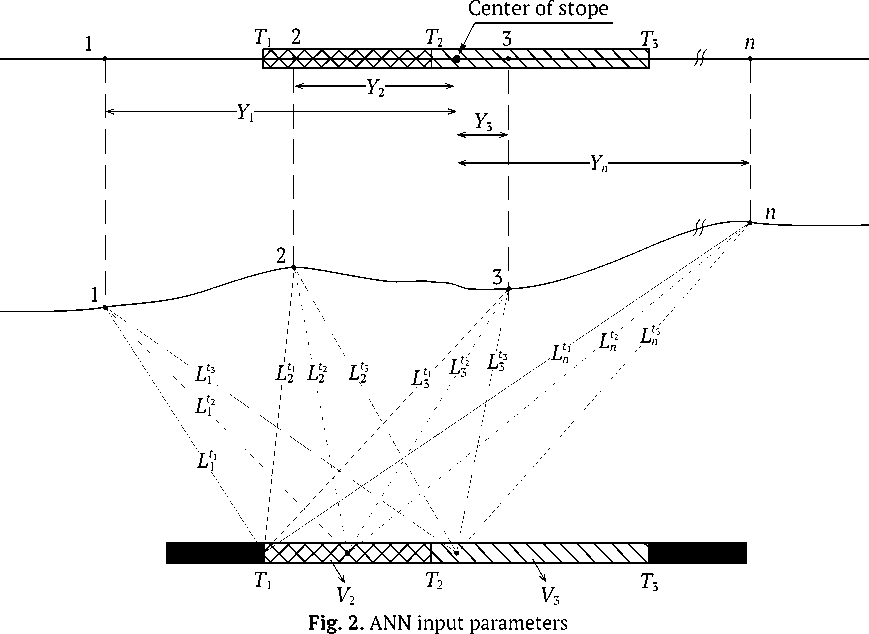
2021;6(4):241–251
– The number of neurons in each hidden layer should be equal to two-thirds of the sum of the number of neurons in the input and output layers.
– The number of neurons in each hidden layer should be calculated by the following formula [23]:
i < 1 + Vm(l + 3), (4)
where: m is the number of training cycles, l is the number of hidden layers.
In this study, the selected feed-forward neural network for the prediction of surface subsidence through time at Mong Duong underground coal mine has 1-hidden layer ANN architecture with 4 neurons in the hidden layer. Thus, the input layer consists of 4 neurons, each of which represents a parameter: monitoring time ( Ti ), volume of stope (coal extracted) ( Vi ), distance from the center of the coal extraction stope to monitoring points on the surface ( L t i i ), and coordinates of the monitoring points on the surface ( Yi ). The hidden layer also consists of 4 neurons that determines the general relationship between the parameters influencing the mine surface subsidence. The output layer has only one neuron and its output is the predicted subsidence value (Fig. 3).
Input layer Hidden layers Output layer
T i
V i
L it i
Y i
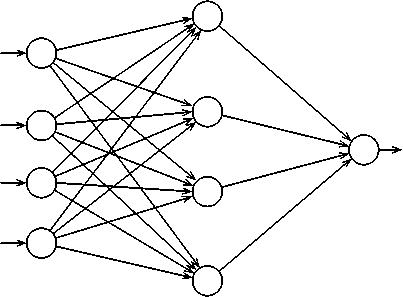
Subsidence
Fig. 3. Architecture of ANN for subsidence prediction
5. Trainning feed-forward ANN
The ANN training data includes collected data and subsidence monitoring data along monitoring line P, the main cross-section of the subsidence trough, located above stope No. 2 in coal seam No. 9 of North Mong Duong at Mong Duong underground coal mine. Coal extraction in stope No. 2 started in the second quarter of 2013 and was completed in the second quarter of 2014.
The monitoring line P in the direction of extraction propagation was arranged with 22 monitoring points. The distance between them ranges 10 to 30 m. The subsidence monitoring was carried out for 2 years with a 2-month cycle (total of 12 monitoring cycles), using a Leica NAK2 automatic level which meets the mine surveying technical requirements. The elevations of the monitoring points were measured against the benchmark of class IV levelling accuracy. After completion of the monitoring in 2014, the mine surface was re-surveyed to ensure accurate determination of the maximum subsidence value. After stopping the cyclical subsidence monitoring, the mine surface was re-monitored to ensure accurate determination of the maximum subsidence value.
The cyclical subsidence monitoring data and 4 input parameters (the extraction volume, the distance from the stope center to the monitoring points on the surface, the coordinates of the monitoring points and the time) corresponding to these cycles formed the training and validation data files. The subsidence monitoring data of the remaining cycles were used to test and evaluate the subsidence prediction accuracy of the ANN.
The ANN for ground surface subsidence prediction through time was trained in 5 cases as follows:
Case 1: Using the data of the first 11 cycles for training; the subsidence in the last cycle was used to evaluate the ANN prediction accuracy.
Case 2: Using the data of the first 10 cycles for training, the subsidence in the next 2 cycles was used to evaluate the prediction accuracy of the ANN.
Case 3: Using the data of the first 9 cycles for training, the subsidence in the next 3 cycles was used to evaluate the ANN prediction accuracy.
Case 4: Using the data of the first 8 cycles for training, the subsidence in the next 4 cycles was used to evaluate the ANN prediction accuracy.
Case 5: Using the data of the first 7 cycles for training, the subsidence in the next 5 cycles was used to evaluate the the ANN prediction accuracy.
The described training and prediction data of the monitoring cycles are shown in Table 1.
Table 1
ANN training and prediction
|
Case |
Monitoring cycles for training |
Monitoring cycles for prediction |
|
1 |
1, 2, 3, … , 9, 10, 11 |
12 |
|
2 |
1, 2, 3, … ,8 , 9, 10 |
11, 12 |
|
3 |
1, 2, 3, … , 7, 8, 9 |
10,11,12 |
|
4 |
1, 2, 3, …, 6, 7, 8 |
9, 10,11,12 |
|
5 |
1, 2, 3, 4, 5, 6, 7 |
8, 9, 10,11,12 |
In all the 5 cases, the data of the first cycles used to build the predictive model were randomly divided in the proportion of 60 %, 20 %, and 20 % corresponding to the training files, validation files, and testing files, respectively.
The training data set (Fig. 4) is in MS Excel format with 5 columns (corresponding to 4 input parameters and the monitored subsidence values in the monitoring points) and many rows (the number of rows depends on the training data amount).
The training and prediction data were normalized using formula (5):
У =
x x min
X -X .
max min
where: x , y are the pre-normalized and post-normalized values of the input parameters, respectively; x max and x min are the pre-normalized maximum and minimum values of each input parameter.
2021;6(4):241–251
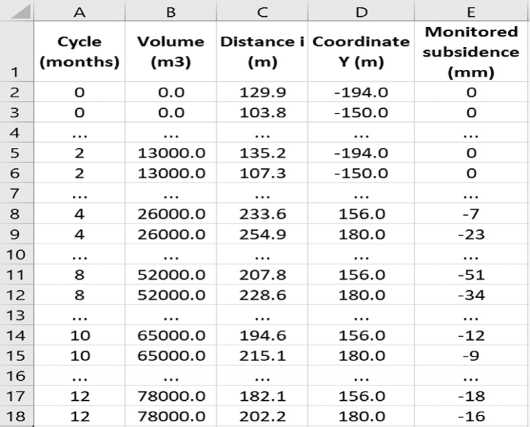
Fig. 4. Structure of training data file in MS Excel format
We have built the model based on Matlab platform (version R2016a) for ANN training and ground surface subsidence prediction in underground mining areas. In this modular programming, we used some neural network functions in the Neural Network Toolbox of Matlab, which gave reliable results and saved programming time.
The training process of the feed-forward ANN for subsidence prediction gave good results at all 3 stages: training, validation, and testing. In the first 4 cases, the output errors were tiny and gradually tended to approaching “0”, as shown in Fig. 5, a (training, validation, and testing error curves), Fig. 5, b (histograms of training, validation, and testing errors) and Fig. 6 (coefficients of correlation between the predicted subsidences and the actual subsidences).
This all showed that that the feed-forward ANN was successfully trained and ready for subsidence prediction.
Best Validation Performance is 0.00061832 at epoch 23
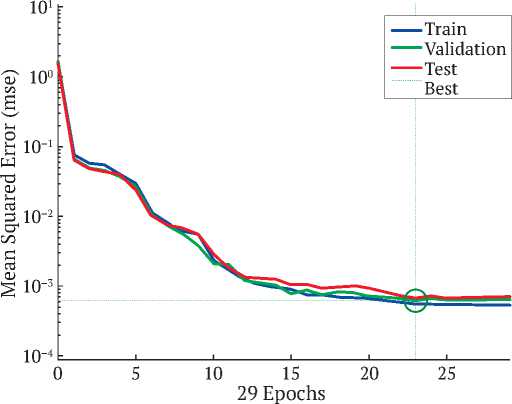
( a )
Fig. 5. ( a ) Error curve for ANN training ( b ) Error histogram for ANN training
Error Histogram with 20 Bins

Errors = Targets – Outputs
( b )
Training: R = 0.9963
~= 0.99 * Target + 0.01
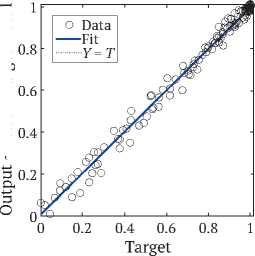
( a )
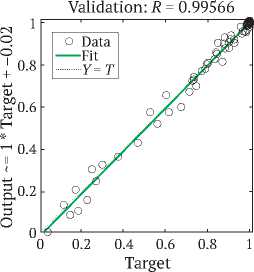
( b )
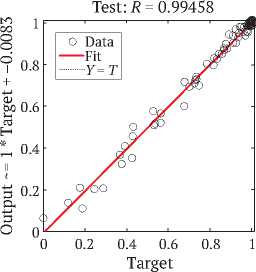
( c )
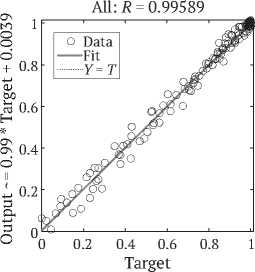
( d )
Fig. 6. Ccoefficients of correlation between the feed-forward ANN predicted subsidences and the actual subsidences: (a) for training data, (b) for validation data, (c) for testing data, and (d) for all the data https://mst.misis.ru/
2021;6(4):241–251
6. Evaluation of subsidence prediction accuracy
The accuracy of the subsidence prediction based on feed-forward ANN was evaluated using the mean absolute error ( MAE ), root mean square ( RMS ), and coefficient of correlation ( r ) between the monitored subsidence (actual subsidence) and the predicted subsidence:
RMS =
1 n
∑(η -ηp)2, n i=1 ii
MAE = ∑n i=1
η i - η i p n
∑n (ηi-ηl)(ηip-ηlp) i =1
r = n 2 , (8)
∑(ηi-ηl)2(ηip-ηlp)
i =1
where: η i and η i p are ac t ual sub s idence and predicted subsidence, respectively; η l and η l p are mean of actual subsidence and predicted subsidence, respectively.
7. Results and discussion
The trained feed-forward ANN was used to predict the subsidence in 22 points on monitoring line P in several cycles. In more details, case 1 predicted the subsidence in cycle 12; case 2 predicted the subsidence in cycles 11 and 12; case 3 predicted the subsidence in cycles 10, 11, and 12; case 4 predicted the subsidence in cycles 9, 10, 11, and 12; and case 5 predicted the subsidence in cycles 8, 9, 10, 11, and 12.
If we let the neural network (ANN) to continuously predict the subsidence, and the training data are available for the first cycles only, the ANN will continue to predict the subsidence while the subsidence process may stop (when the mine/the coal mining stope is no longer exploited). We solved this problem by using training data, namely,
subsidence monitoring data from other subsidence troughs in the mining area. The more subsidence troughs were used to train the ANN, the better and more accurate subsidence prediction was produced by the ANN.
The predicted subsidences were compared with the monitored subsidences in the corresponding cycles. The accuracy of the subsidence prediction results was evaluated based on MAE , RMS and r values (formulas 9, 10, and 11) for all monitoring points in the same cycle. The results of the accuracy evaluation for the 5 cases were as shown in Table 2.
Table 2
Evaluation of subsidence prediction accuracy
|
Case |
Cycle |
RMS ( m ) |
MAE ( m ) |
r |
|
1 |
12 |
0.035 |
0.030 |
0.995 |
|
2 |
11 |
0.031 |
0.023 |
0.995 |
|
12 |
0.036 |
0.027 |
0.993 |
|
|
3 |
10 |
0.026 |
0.018 |
0.996 |
|
11 |
0.031 |
0.021 |
0.996 |
|
|
12 |
0.041 |
0.028 |
0.994 |
|
|
4 |
9 |
0.020 |
0.013 |
0.997 |
|
10 |
0.043 |
0.032 |
0.990 |
|
|
11 |
0.071 |
0.050 |
0.977 |
|
|
12 |
0.081 |
0.059 |
0.967 |
|
|
5 |
8 |
0.107 |
0.095 |
0.996 |
|
9 |
0.156 |
0.132 |
0.922 |
|
|
10 |
0.171 |
0.137 |
0.899 |
|
|
11 |
0.189 |
0.152 |
0.898 |
|
|
12 |
0.197 |
0.160 |
0.999 |
Case 1: the errors of subsidence prediction RMS = 0.035 m and MAE = 0.030 m were equivalent to 4.3% and 3.7 %, respectively, of the maximum subsidence in cycle 12 (which was equal to -0.814 m ). The coefficient of correlation ( r ) between the actual subsidence and the predicted subsidence in cycle 12 was 0.995. Figure 7 shows the actual and predicted subsidence curves in cycle 12.
Distance from monitoring points to center of subsidence trough ( m )
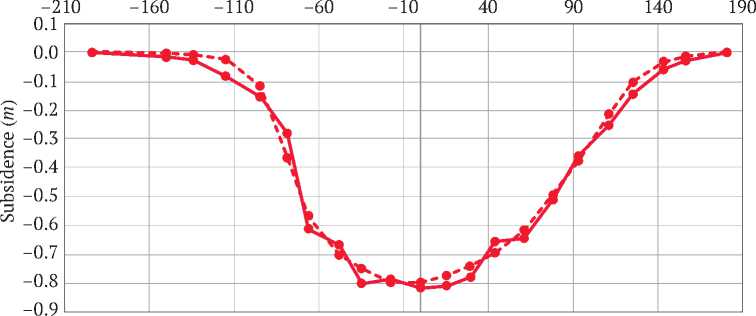
Predicted subsidence of cycle 12 (Pre 12)
Actual subsidence of cycle 12 (Act 12)
Fig. 7. Actual and predicted subsidence curves in cycle 12 (Case 1)
2021;6(4):241–251
Case 2 : in cycle 11, the errors of subsidence prediction RMS = 0.031 m and MAE = 0.023 m were equivalent to 4.1 % and 3.0 %, respectively, of the maximum subsidence in cycle 11 (which was equal to -0.686 m ). The coefficient of correlation r = 0.995. In cycle 12, RMS = 0.036 m , MAE = 0.027 m were equivalent to 4.4 % and 3.3 %, respectively, of the maximum subsidence in cycle 12. The correlation coefficient r = 0.993. Figure 8 shows the actual and predicted subsidence curves in cycles 11 and 12.
Case 3 : in cycle 10, the errors of subsidence prediction RMS = 0.026m and MAE = 0.018m were equivalent to 3.6 % and 2.5 %, respectively, of the maximum subsidence in cycle 10 (which was equal to -0.580m). In cycle 11, RMS = 0.031 m , MAE = 0.021 m were equivalent to 3.9 % and 2.6%, respectively, of the maximum subsidence in cycle 11. In cycle 12, RMS = 0.041 m , MAE = 0.028 m were equivalent to 5.0 % and 3.4 %, respectively, of the maximum subsidence in cycle 12. The correlation coefficients in all 3 cycles were very close to 1, namely, 0.999, 0.996, and 0.994 in cycle 11, cycle 12, and cycle 13. respectively. Figure 9 shows the actual and predicted subsidence curves in cycles 10, 11, and 12. Thus, in all 3 cycles, the MAE and RMS characterizing the accuracy of subsidence prediction
were tiny, and the predicted and actual subsidence curves proved to be very close to each other. This clearly demonstrated that the subsidence prediction results were characterized by rather good accuracy.
Case 4 : in cycle 9, the errors of subsidence prediction RMS = 0.020 m and MAE = 0.013 m were equivalent to 3.0 % and 2.0 %, respectively, of the maximum subsidence in cycle 9 (which was equal to -0.461 m ). In cycle 10, RMS = 0.043 m and MAE = 0.032 m sequentially equivalent to 5.9 % and 4.4 % of the maximum subsidence of cycle 10. In cycle 11, RMS = 0.071 m , MAE = 0.050 m were equivalent to 9.3 % and 6.6 %, respectively, of the maximum subsidence in cycle 11. In cycle 12, RMS = 0.081 m , MAE = 0.059 m were equivalent to 9.9 % and 7.3 %, respectively, of the maximum subsidence in cycle 12. The correlation coefficients r in these 4 cycles were different. The correlation coefficients r were 0.997 and 0.995, very close to 1, in cycles 9 and 10, respectively, and gradually decreased in cycles 11 and 12 to 0.977 and 0.967, respectively.
We see that the values of MAE and RMS of the subsidence prediction in cycles 9 and 10 were tiny, but increased in cycles 11 and 12. Simultaneously, the correlation coefficient was high in cycle 9 and gradually
Distance from monitoring points to center of subsidence trough ( m )

Fig. 8. Actual and predicted subsidence curves in cycles 11 and 12 (Case 2)
Distance from monitoring points to center of subsidence trough ( m )
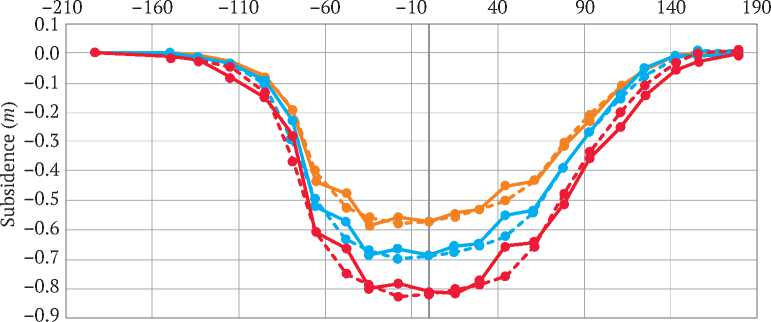
--••-Pre 10 • Act 10 --*-Pre 11 • Act 11 --*-Pre 12 • Act 12
Fig. 9. Actual and predicted subsidence curves in cycles 10, 11, 12 (Case 3)
2021;6(4):241–251
decreased for cycles 10, 11, and 12. These showed that the predicted subsidence error increases with increasing the period lasted from the monitoring cycles (used to train the ANN) time to the prediction time.
Figure 10 shows that predicted and actual subsidence curves are very close to each other in cycles 9, 10, and 11, demonstrating that the predicted subsidences have high accuracy.
Analysis of the results of cases 3 and 4 showed that, although the number of subsidence monitoring cycles used to train the ANN was large (at least 8 cycles), we should use the ANN to predict the subsidence for the next 3 cycles only, and then should continue monitoring to update the ANN model input parameters to ensure the prediction accuracy.
Case 5: in cycle 8, the errors of subsidence prediction RMS = 0.107 m and MAE = 0.095 m were equivalent to 31.4 % and 11.8 %, respectively, of the maximum subsidence in cycle 8 (which was equal to -0.341 m ). This was the most accurate subsidence prediction result in case 5, while even its prediction accuracy was much inferior of that in cases 1, 2, 3, and 4. The reason of this insufficient accuracy was that the number of monitoring cycles (used
for the ANN training) in case 5 was only 7, less than that used in cases 1, 2, and 3.
In cycles 9, 10, 11, and 12, the values of RMS and MAE were larger than those in cycle 8. For instance, RMS values in cycles 9, 10, 11, and 12 were 33.8 %, 29.5 %, 32.6 %, and 33.9 %, respectively, of the maximum subsidence. Similary, MAE values in cycles 9, 10, 11, and 12 were 28.6 %, 23.6 %, 26.2%, and 27.6 %, respectively, of the maximum subsidence. The correlation coefficients in all the cycles were much lower than those in the previous four cases. Figure 11 shows that, in all the cycles, the predicted and actual subsidence curves differ markedly from each other.
It can be seen that if we would like to predict the subsidence with high accuracy, we should use at least 8 cycles as ANN training data. However, if many monitoring cycles are used as the training data, only few cycles further can be predicted, providing low practical significance of the subsidence prediction through time. At the same time, to improve subsidence prediction through time, it is expedient to use more data of other similar subsidence troughs in the same mining area as ANN training data.
Distance from monitoring points to center of subsidence trough ( m )
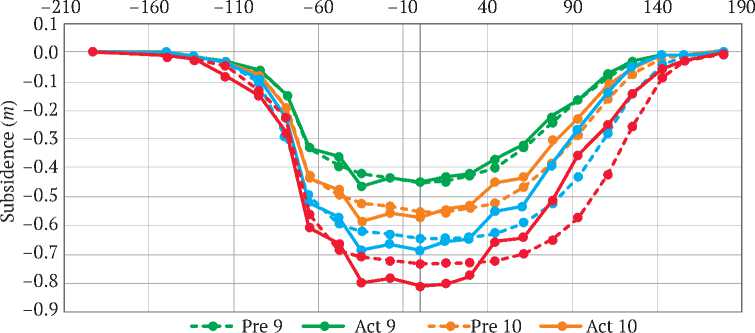
--••- Pre 11 —•— Act 11 -*-Pre 12 • Act 12
Fig.10. Actual and predicted subsidence curves in cycles 9, 10, 11, and 12 (Case 4)
Distance from monitoring points to center of subsidence trough ( m )
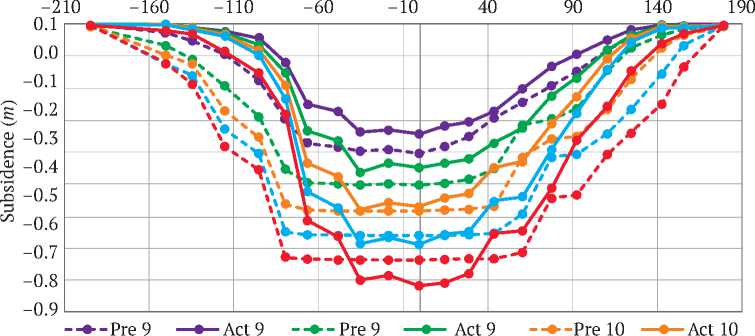
--•■-Pre 11 • Act 11 -*- Pre 12 • Act 12
Fig. 11. Actual and predicted subsidence curves in cycles 8, 9, 10, 11, and 12 (Case 5)
2021;6(4):241–251
8. Conclusion
The three-layer feed-forward neural network applying back-propagation algorithm, the most common training algorithm, form a suitable ANN model to predict subsidence of monitoring points located on the surface along the main profile within a subsidence trough in underground coal mining area.
The quality (accuracy and reliability) of the subsidence prediction in the area of Mong Duong underground coal mine depended on the number of ANN training monitoring cycles as well as the time interval between the cycles to be predicted and the last monitoring cycle used to train the neural network. When the number of the monitoring cycles used for training the neural network was greater than 8, the subsidence prediction results were very accurate. This was demonstrated by closeness of the predicted subsidence curves to the actual subsidence curves, as well as by the corresponding values of RMS , MAE , and the coefficient of correlation ( r ) between the actual subsidence and the predicted subsidence. For instance, the maximum values of RMS and MAE were 10 % lower than the maximum actual subsidence, and the correlation coefficient was more than 0.9 (practically equal to 1).
When the number of monitoring cycles used for training the neural network was 7, the subsidence prediction results were significantly less accurate. This was illustrated by the deviation of the predicted subsidence curve from the actual subsidence curve. At the same time, RMS and MAE of the predicted subsidence in cycle 8, which provided the most accurate prediction result, were only 14.5 % and 11.3 %, respectively, of the maximum actual subsidence. The values of these parameters in the following cycles were even higher, about 30 % and 20 %, respectively. Thus, when the training data were provided by less than 8 cycles, the subsidence prediction can not ensure acceptable accuracy.
The results of the case study at Mong Duong underground coal mine showed that ANNs were effective in predicting subsidence in underground mining areas. However, in order to improve practicality of ANN subsidence prediction, one should perform extensive studies with a large set of ANN traning data, for instance, data on subsidence from many other subsidence troughs, as well as test other neural networks which can prove to be more suitable for this training dataset.
Список литературы Prediction of ground subsidence due to underground mining through time using multilayer feed-forward artificial neural networks and back-propagation algorithm - case study at Mong Duong underground coal mine (Vietnam)
- Long N. Q., Ahmad A., Cuong C. X., Canh L. Van. Designing observation lines: a case study of the G9 seam in the Mong Duong colliery. Journal of Mining and Earth Sciences. 2019;60(3):18–24. URL: https://www.researchgate.net/publication/333560617_Designing_observation_lines_a_case_study_of_the_G9_seam_in_the_Mong_Duong_colliery
- Ambrožič T., Turk G. Prediction of subsidence due to underground mining by artificial neural networks. Computers and Geosciences. 2003;29(5):627–637. https://doi.org/10.1016/S0098-3004(03)00044-X
- King M. A., Watson C. S. Long GPS coordinate time series: Multipath and geometry effects. Journal of Geophysical Research: Solid Earth. 2010;115(4):1–23. https://doi.org/10.1029/2009JB006543
- Yang W., Xia X. Prediction of mining subsidence under thin bedrocks and thick unconsolidated layers based on field measurement and artificial neural networks. Computers and Geosciences. 2013;52:199–203. https://doi.org/10.1016/j.cageo.2012.10.017
- Cong Khai P., Tran D. T., Nguyen V. H. GNSS/CORS-Based Technology for Real-Time Monitoring of Landslides on Waste Dump – A Case Study at the Deo Nai South Dump, Vietnam. Inżynieria Mineralna. 2020;1(2):181–191. https://doi.org/10.29227/IM-2020-02-23
- Hejmanowski R., Witkowski W. T. Suitability assessment of artificial neural network to approximate surface subsidence due to rock mass drainage. Journal of Sustainable Mining. 2015;14(2):101–107. https://doi.org/10.1016/j.jsm.2015.08.014
- Zhao K., Chen S. N. Study on artificial neural network method for ground subsidence prediction of metal mine. Procedia Earth and Planetary Science. 2011;2(1):177–182. https://doi.org/10.1016/j.proeps.2011.09.029
- Kim K. D., Lee S., Oh H. J. Prediction of ground subsidence in Samcheok City, Korea using artificial neural networks and GIS. Environmental Geology. 2009;58(1):61–70. https://doi.org/10.1007/s00254-008-1492-9
- Kim Y., Son M., Moon H. K., Lee S. A. A study on the development of an artificial neural network model for the prediction of ground subsidence over abandoned mines in Korea. Geosystem Engineering. 2017;20(3):163–171. https://doi.org/10.1080/12269328.2016.1254573
- Lee S., Park I., Choi J. K. Spatial prediction of ground subsidence susceptibility using an artificial neural network. Environmental Management. 2012;49(2):347–358. https://doi.org/10.1007/s00267-011-9766-5
- Hu Q., Deng X., Feng R., Li C., Wang X., Jiang T. Model for calculating the parameter of the Knothe time function based on angle of full subsidence. International Journal of Rock Mechanics and Mining Sciences. 2015;78:19–26. https://doi.org/10.1016/j.ijrmms.2015.04.022
- Wang C., Ji H. Analysis on the improved time function model of surface subsidence. Electronic Journal of Geotechnical Engineering. 2015;19:615–627.
- Zhanqiang C., Jinzhuang W. Study on time function of surface subsidence the improved Knothe time function. Chinese Journal of Rock Mechanics and Engineering. 2003;9.
- Long N. Q., My V. C., Luyen B. K. Divergency verification of predicted values and monitored deformation indicators in specific condition of Thong Nhat underground coal mine (Vietnam). Geoinformatica Polonica. 2016;15:15–22. https://doi.org/10.4467/21995923GP.16.002.5479
- Cui X., Miao X., Wang J., Yang S. et al. Improved prediction of differential subsidence caused by underground mining. International Journal of Rock Mechanics and Mining Sciences. 2000;37(4):615–627. https://doi.org/10.1016/S1365-1609(99)00125-2
- Gonzalez-Nicieza C., Alvarez-Fernandez M. I., Menendez-Diaz A., Alvarez-Vigil A. E. The influence of time on subsidence in the Central Asturian Coalfield. Bulletin of Engineering Geology and the Environment. 2007;66(3):319–329. https://doi.org/10.1007/s10064-007-0085-2
- Liu X., Wang J., Guo J., Yuan H., Li P. Time function of surface subsidence based on Harris model in mined-out area. International Journal of Mining Science and Technology. 2013;23(2):245–248. https://doi.org/10.1016/j.ijmst.2013.04.012
- Haykin S. Neural Networks: A Comprehensive Foundation. 2nd Edition. 2004.
- Rumelhart D. E., Hinton G. E., Williams R. J. Learning representations by back-propagating errors. Nature. 1986;323:533–536. https://doi.org/10.1038/323533a0
- Long N. Q. A novel approach of determining the parameters of Asadi profiling function for predictiong ground subsidence due to inclied coal seam mining at Quang Ninh coal basin. Journal of Mining and Earth Sciences. 2020;61(2):86–95. https://doi.org/10.46326/JMES.2020.61(2).10
- Atiya A. F. Learning algorithms for neural networks. California Institute of Technology, Pasadena, California. 1991. URL: https://thesis.library.caltech.edu/3725/1/Atiya_a_1991.pdf
- Heaton J. Introduction to neural networks with Java. 2nd Edition. Heaton Research, Inc. 2008. 439 p.
- Dayong Y., Jun S. Prediction method for evolutionary neural net of strata subsidence of rock Mass. Mining Safety & Environmental Protection. 2002;29(3):11–13. (In Chin.).

